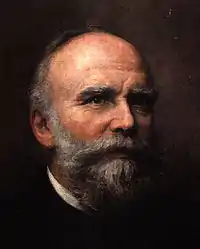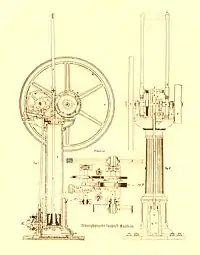Eugen Langen
Carl Eugen Langen (9 October 1833 in Cologne – 2 October 1895 in Elsdorf) was a German entrepreneur, engineer and inventor, involved in the development of the petrol engine and the Wuppertal Suspension Railway. In 1857 he worked in his father's sugar factory, JJ Langen & Söhne, and after extensive technical training at the Polytechnic institute in Karlsruhe, patented a method for producing sugar cubes. He sold this method in 1872 to Sir Henry Tate of England, founder of the Tate Gallery in London.


Otto and Langen
In 1864, Langen met Nicolaus August Otto who was working to improve to the gas engine invented by Belgian Etienne Lenoir. The technically–trained Langen recognized the potential of Otto's development, and one month after the meeting, founded the first engine factory in the world, NA Otto & Cie. At the 1867 Paris World Exhibition, their improved engine received the Grand Prize.[1]
Deutz
After this first factory went bankrupt, Langen founded a new company for the construction of gas engines, Gasmotoren-Fabrik Deutz, which later became the group Kloeckner-Humboldt-Deutz (KHD).[2] This became the current Deutz AG. Langen invented and applied new methods of production in the KHD factory.
Railway equipment
In the field of rail transport equipment, Langen was co-owner and engineer of the Cologne Waggonfabrik van der Zypen & Charlier. He started the suspension railway system in Wuppertal in 1894.
See also
- In the German Empire, Eugen Langen was a leading entrepreneur in the sugar and motor industry in Cologne and the Rhineland.
Eugen Langen was born on October 9th, 1833 in Cologne. He was the fifth of six sons of the factory owner Johann Jakob Langen (1794-1869), who ran a sugar refinery in Cologne (Johann Jakob Langen & Söhne) and the Friedrich-Wilhelms-Hütte near Siegburg (since 1855 Siegrheinischer Bergwerks- und Hüttenverein). After dropping out of his studies in chemical or chemical engineering and mechanical engineering at the Polytechnic in Karlsruhe, Eugen Langen also developed entrepreneurial talent. After temporary holdings, he joined his father's factories in 1858, which he continued after his father's death. In 1870, together with Emil Pfeifer (1806-1889), he founded the Pfeifer & Langen sugar factory in Elsdorf (Rhein-Erft district) and intensified the cultivation of beet sugar in the Rhineland through an affiliated agricultural department. The processing of beet sugar instead of the refining of imported colonial or raw sugar was a major innovation in the second half of the 19th century. With the addition of a refinery in 1880, Pfeifer & Langen was the first company in the Rhineland to benefit from the so-called campaign, the Beet harvest from October to December of each year, independently and was able to produce white household sugar all year round. In addition to other patented inventions, it was the process for producing sugar cubes that made Langen famous beyond the borders of the Rhine area. Langen's connection with engine developer Nicolaus August Otto was also of great entrepreneurial and technical importance. In 1864 Langen and Otto founded the company “N. A. Otto & Cie ", which in 1872 in the" Gas engine factory Deutz A.G. " (today Deutz AG, Cologne) was renamed. In 1876, Otto brought the concept of a four-stroke engine ("Otto engine") he had been pursuing for years to patent maturity. Langen's financial opportunities stemming from the sugar industry and his father's legacy made him and his brothers major investors in the gas engine factory; For many years, Langen was a member of the Executive Board and played a key role in the management and industrial exploitation of Otto engines, and it was not least on his initiative that he collaborated with the two technicians Gottlieb Daimler (1834-1900) and Wilhelm Maybach (1846-1929), who later worked for Daimler -Motoren-Gesellschaft in Stuttgart (today Daimler AG) made a career, back in the early days of the Deutz gas engine factory. In addition to the sugar lump and the Otto engine, Eugen Langen is always associated with the suspension railway, a single-track suspension railway system designed by him, which was only put into operation in Wuppertal in 1901, as the underground railways were preferred at the turn of the century: “The Suspension railway is in the air / If only the project doesn't fizzle out / And doesn't run away as a sweet madness / The high-altitude suspension railway "caricatured the" Lustige Blätter "in its 17th edition in 1895. Langen was also involved in a large number of supervisory boards in the electrical and transport industry as well as in banks and insurance companies (e.g. Badische Schrauben-Dampfschiffahrtsgesellschaft, Mannheim; Electrizitäts-Actien-Gesellschaft vorm. Schuckert & Co., Nuremberg; A. Schaaffhausen'scher Bankverein , Cologne; Rheinisch-Westfälische Bodenkreditbank, Cologne; Colonia Feuerversicherungsgesellschaft, Cologne). In the electrical industry in particular, he was interested in the electrification of industrial companies and cities in connection with the gas engine. Eugen Langen was a representative of his branch of industry in the respective economic associations. As an association member of the beet sugar industry and the refining industry - partly in chairmanship - he argued for a merger of both branches of production in the face of increasing overproduction of sugar and falling prices. In 1892 the Rhenish refineries merged to form the first syndicate. In 1900, five years after Langen's death, the first all-German sugar cartel was formed from beet sugar manufacturers and refiners. Because of his commitment to a generally applicable patent law, he was called "Patent-Langen". As recently as 1850, around 90 percent of all patents in Prussia had been rejected, and patented inventions usually only had a term of protection of three years. A patent was valid for that Time for the free trade-oriented circles of Prussia as a restriction of free commercial rights of use. Eugen Langen therefore campaigned for patent protection at the beginning of the 1870s in the Cologne district of the Association of German Engineers (VDI). Werner von Siemens (1816-1892) became an important participant in Berlin. On the basis of the drafts of the VDI, the government passed a German patent law in 1877, which since then has provided for a 15-year patent period. Politically conservative, Langen also supported the colonial-political endeavors of the German East African Society, the German Colonial Society and the undertakings of his later son-in-law Hermann von Wissmann (1853-1905) to explore the East African lakes (Lake Malawi and Lake Tanganyika). In addition, Langen emerged as a church building sponsor in Cologne and Elsdorf. In Cologne, he promoted the construction of the Protestant Christ Church at the Stadtgarten, in which he - also in his capacity as city councilor - vigorously campaigned for the acquisition of a corresponding piece of land and accompanied the architectural competition and the construction. For the Christ Church, he donated the font made by the sculptor Heinrich Renard (1868-1928). In Elsdorf, he had the church in the Zieverich district, consecrated in 1895, built: the property, a foundation and a loan came from him, his son Gottlieb took over the construction management. The aim was to give the evangelical workers of Pfeifer & Langen a religious home. Langen was married twice. His first wife Henriette (1834-1872), daughter of the Basel paper manufacturer Andreas Thurneysen, died giving birth to their tenth child. His second marriage was to his niece Hermine Schleicher (1849-1935). He had a total of thirteen children, including Eugen Gottlieb von Langen (1896-1982), 1958-1965 President of the Cologne Chamber of Commerce and Industry, and Hans Rudolf von Langen (1863-1935), who with Robert Gerling helped found his insurance company , and Arnold Langen (1876-1947), who initiated the merger of the Deutz gas engine factory and the Humboldt mechanical engineering company. Eugen Langen died shortly before his 62nd birthday on October 2nd, 1895 as a result of food poisoning at Gut Etzweiler near Elsdorf. He was buried in the family grave in the Melaten cemetery in Cologne.
In the Marienburg district of Cologne, a street and in front of the Deutz train station a memorial of the first atmospheric gas engine from 1864, the forerunner of the four-stroke Otto engine, remind of Eugen Langen. He received another honor in November 1990 when he was included in the figure program of the Cologne Council Tower (sculptor: Theo Heiermann.) This article is a Google translation from a Portal Rheinische Geschichte article about Eugen Langen.
- German inventors and discoverers
References
| Wikimedia Commons has media related to Eugen Langen. |
- Wise, David Burgess. "Daimler: Founder of the Four-Wheeler", in Northey, Tom, ed. World of Automobiles (London: Orbis, 1974), Volume 5, p.483, subscription required.
- [www.britannica.com/EBchecked/topic/.../Eugen-Langen Eugen Langen] at Britannica.com